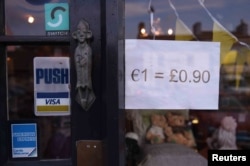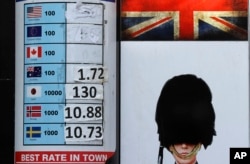It ranks as one of the most disingenuous claims ever made by a modern British politician.
Buffeted by a balance of payments crisis, Britain was forced in 1967 to devalue the pound by nearly 15 percent against the dollar, prompting the then-prime minister, Harold Wilson, to try to reassure a skeptical public that it "does not mean that the pound here in Britain, in your pocket or purse, or in your bank, has been devalued."
Britons soon found otherwise, as living standards were hit and prices skyrocketed because much of what consumers bought, including a bulk of their food, was imported. Prices for many British-made goods also rose, because manufacturers' costs jumped as a result of wage inflation and because the raw materials and supplies producers needed from abroad became more expensive.
Now, another British leader is seeking to make light of a plunging pound, which briefly traded at $1.13 at one point this month, its lowest level in 31 years. The pound has recovered slightly and on Monday was trading at $1.22, still an eye-catching low.
But there are signs of further drops to come, with investors, businesses and currency traders fearful of the economic consequences of Britain's Brexit vote in June and indications the government is inexorably heading for a hard break with Europe, one that will see Britain outside the free-trading single market.
Hedge funds, investors and currency speculators are now shorting sterling in volumes not seen, even during the 2008 financial crash.
Fears of downward trend
Prime Minister Theresa May and her ministers dismiss fears about the sharp slide in the pound's value, arguing it is normal for currencies to "go up and down."
But most analysts, seeing only a downward trend with little prospect of a sustainable upswing over the next two years, question whether the pound will be viewed in the future as one of the world's major convertible currencies.
Major banks have cut their forecasts for the pound's value. Rabobank is forecasting the pound trading consistently at around $1.18 by mid-2017. HSBC predicts the pound will be down at $1.10 by the end of next year.
Some investors are even gloomier. Jim Rogers, who co-founded Quantum Fund with George Soros, thinks the pound will likely hit parity with the dollar and could trade even lower in three or four years’ time, if Scotland breaks away from Britain.
Speaking to the BBC on Saturday, Rogers said, "If Scotland leaves, they are going to take their oil with them and the pound could go down a great deal. It would certainly go down under one U.S. dollar."
Upside to weaker pound
Government ministers scorn the claim. They say a weaker pound is a godsend and will boost British exports by making them cheaper.
That position is held by the authors of a new book, “The Real Sterling Crisis,” by economist Roger Bootle and entrepreneur John Mills. Both have long chafed at what they consider an over-valued pound and would prefer the government control of exchange rates.
They welcome the Brexit-inspired bout of sterling weakness.
"Far from panicking about the lower pound, the UK authorities should be concerning themselves with the question of how they can ensure that the pound continues to trade at a competitive level in the future," they argue in their book.
"An exchange rate that is too high for extended periods will tend to lead to an unbalanced economy with too small a manufacturing sector. It is our contention that this is exactly what has happened in the UK," they add.
‘The great devaluation myth’
But other economists dismiss the argument.
John Ashcroft, an economist, businessman and visiting professor at Manchester Metropolitan University's Business School, fears "the great devaluation myth."
He maintains there was no major improvement in trade after previous currency depreciations — including Wilson's 1967 devaluation, and the plunge in the value of the pound after Britain's 1992 exit from the European Exchange Rate Mechanism. Nor after the last financial crash.
"The depreciation of sterling in 2008 did not lead to a significant improvement in the balance of payments,” according to Ashcroft. “There was no ‘re-balancing effect.’”
The Economist magazine argued this week that May and her ministers are being too complacent about the plunging value of the pound, editorializing that "recent experience suggests that British exports do not respond quickly or strongly to a cheaper currency."
The magazine stressed that British manufacturers are facing higher production costs because of more expensive supplies and other materials they need to import.
Despite the falling pound, "The volume of exported goods is actually lower than it was before the Brexit vote," it noted.












